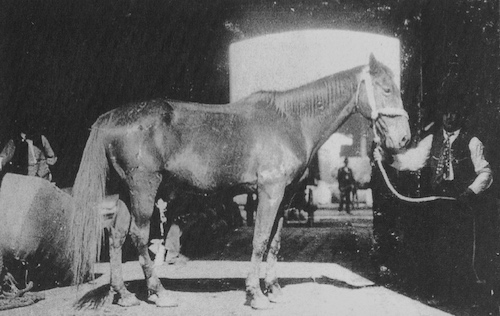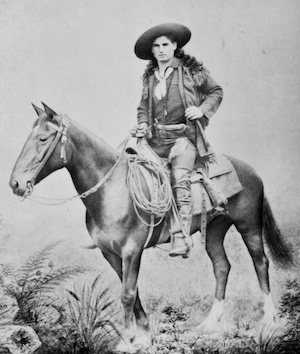The Days of Martini’s Buckjumping Show
EPILOQUE
© Chris Woodland
‘Mrs Martini’
Mart’s partner, referred to as Mrs Martini, was actually born Julia Kelson in New Zealand, and was affectionately known as Jewls. As we have seen, her stage name was Jessie Devine. Jessie married M. J. Ryan within two years of Mart’s death. Despite his first initial Julia’s husband was known as James. The Ryans had only one child, Gweneth, who was 22 years of age when her mother died in October 1937 at Burwood, Sydney. Following the sale of the travelling buckjumping show, Ryan became a well know Sydney bookmaker.
Billy Waite
The remarkable life of this amazing man began in July 1880. Billy Waite was reared from an infant on Breadalbane, a sugar cane property near Proserpine, near Mackay in North Queensland. He took his surname from the owner of the property. It was said that his mother was Aboriginal and his father European. He grew into a fine specimen of a young man with an athletic build and handsome features. He was the winner of many foot races in the district.
His life changed dramatically when Martini’s Buckjumping Show came through the district where he and another Aboriginal, Billy Emmerson, were only too keen to accept the proprietor’s challenge to attempt to earn a few pounds and fame by riding the already famous outlaw Dargan’s Grey. Neither Waite or Emmerson stayed in the saddle very long, but Martini was impressed with their ability and offered them a job with his travelling show. As both men were classified as Aboriginal, therefore denied the freedom of movement, the local police would not permit them to leave the district. Journalist and writer Bill Bowyang, who was working at Proserpine at the time, sent a telegram to the local member for Bowen in the Brisbane parliament seeking permission for them.
Two days later as the two horsemen were saddling up to head back to their places of employment, having given up hope of approval, the telegram of consent came through. Though both men were joyously happy at the news, Emmerson decided that buckjumping was not for him and returned home.
The place of this famous horseman’s birth in 1880 is said to have been in either Charters Towers or Proserpine. As mentioned earlier his father was European and his mother was Aboriginal.
During World War 1 Billy Waite and his wife moved to Canada from England where Waite broke in horses for the war effort. The famous Scottish poet, and honorary Australian,was also contributing his bit for the war effort at the same place. (( Ogilvie was in Australia for 12 years from 1888 until 1900. He wrote lyrical bush poems which are some of our best and his poetry is still favoured by many people in the outback. ))
The two must have given the Canadians wonderful displays of buckjumping. (( Apparently, Waite had also broken in horses for the Boer War at Proserpine prior to his meeting up with Martini. ))
Crossing the border into the USA Waite intended to obtain a job with the renowned William ‘Buffalo Bill’ Cody, but was taken up and toured with the Orpheum circuit. Waite and his wife were cracking whips and throwing miniature boomerangs. One of the whips was a 65 ft (19.8 m) whip.
For some years the Waites were touring the American and Canadian vaudeville circuit and Billy won many roughriding contests at rodeos.
An Australian part-time resident of the USA was the renowned Snowy Baker. Baker’s life has filled books telling of his many sporting achievements, boxing, teaching movie stars how to ride and performing on horseback. He is also remembered for his vitriolic attacks on Australia’s young battling hero Les Darcy. While in Chicago the famous cowboy actor Tom Mix told Baker that he had seen Waite ride in an English saddle on the worst bucker they could find. He rode the horse while continually cracking a stockwhip. The Waites were living in Chicago at the time and Billy had given up riding rough uns entirely.
Performer Violet Skuthorpe, the daughter of Lance, while visiting the USA caught up with the Waites in Chicago and brought their best wishes back to their friends in Australia.
The English Experience
Things did not succeed as they had hoped in England for the Australian buckjumpers. Bill Bowyang had the following to say of that tour and of the latter life of Billy Waite and his wife:
Disaster came to the “Wild Australia” show in England. Owing probably to changed climatic conditions the horses would not buck, then someone accused Waite and other riders of using cruel devices to make the animals do their part. The show closed down. Finding himself out of work, Billy Waite went to America, …
We remember him as a fine fellow, a good sport, and one of Australia’s greatest buckjump riders.
(Bill Bowyang, the Daily Mercury, Mackay, Qld, Sat 11 Feb 1938.)
The same author had noted in August 1931 that Billy Waite had joined the famous Scottish poet, Will Ogilvie, in breaking horses for the war effort in Canada.
Bobs the Bryamine Outlaw

It is unknown how or where this legendary buckjumper died. It can be sadly assumed that the horse was treated similarly to the whalers that left Australian shores for the battles of WW 1, that is, because of Australia’s strict quarantine laws, they were not allowed to return to Australia. When the short-lived English performances wound up the show horses would have been sold off to other performing shows or to carriers who would have used them as harness horses for deliveries. Bobs passing would certainly have been a vastly different end to that which Dargan’s Grey experienced. The grey was with the show until his end, was respected and would have been kindly treated. Unluckily, the once famous Bryamine Outlaw was in a different environment all together. Different owner(s), who possibly had little or no knowledge of his colourful past. A different, colder climate and unfamiliar sounds, including voices, would have been exceedingly confusing for the old champion. It is not surprising that the news of his death might not have been received in his country of birth and fame, as the war to end all wars was probably in its brutal throes at the time. Fortunately, he will always be remembered, if only for his conquest by Lance Skuthorpe at what is today Eddy Avenue in Sydney in March 1906.
Jack Dempsey, Rider and Runner
This second youngest son of Harry Dempsey, as we have seen, was a well-known horseman and also a champion runner. While in Egypt during WW 1 he won an athletic championship:
… beating a field comprising English, Scots, Irish, New Zealanders, West Indians, French, in fact all nations under the sun.
He rose to the position of squadron sergeant major in the Second Remount Unit, his superior being Banjo Paterson, with whom he remained a lifelong friend. He received an official written thanks from General Sir Charles Chauvel and a commendation from King George the V.
Interestingly, Jack Dempsey had been born on the Upper Murray at a place that was known at the time as ‘No Place’. He died at the age of 65 at the Royal Prince Alfred Hospital in Sydney in May 1950.
Arthur Dempsey
Arthur Dempsey, like his brother Jack, was born at No Place, near Jingellic. He spent a lifetime association with horses. Other than his time with Martini and brother Jack and Billy Waite in their buckjumping venture, he retained his connection with racehorses and trotters. For many years he was an exhibitor of the horse section at the Narrandera Show. He retired and returned to Narrandera a year before he died. His obituary stated he became a resident of Narrandera in 1906 but lived at Leeton for 15 years where he was the poundkeeper. The day he died he had ridden a horse from a Mr Moloney’s place to his son’s home and on returning collapsed in Moloney’s yard. He almost died in the saddle, which would have been an appropriate ending for the old horseman. Arthur Dempsey died in May 1946 aged 63.
Jack Pendergast
Jack Pendergast’s name was associated with Martini’s buckjumping show.
He was a native of the Hawkesbury district from the town of Richmond and retained that address until he followed his parents after they had moved to Forrest Lodge in Sydney. This location was ideal for its proximity to the Christ Church centre where Martini held so many performances.
Pendergast is supposed to have ridden the outlaw Dargan’s Grey on a day at the Hawkesbury when the Grey was not performing as he usually did.
He was a popular horse breaker and broke in many recalcitrant racehorses. A notable horse by the name of Highborn had thrown many jockeys before it was given to Pendergast to tame, which he did. Highborn was to come in second to Martin Henry in 1881 when he won the Melbourne Cup. Coincidentally, it was the year that Mart Breheney became known as Martini.
The only serious accident that this great horseman received was when a mare in Queensland:
… bucked clean over the top of me, and broke four of my ribs. They are racing her in Sydney now.
Like Martini, Jack Pendergast died young. He died of consumption (Tuberculosis) at about the age of 40 in 1908, the year after Martini died.
Texas Jack
From 1891 Texas Jack toured with Harmstons and eventually travelled the country with his own show. He married fellow sharpshooter and horse rider Lily Dunbar at Bundaberg in March 1897.
At the outbreak of the Boer War in late 1899 he tried to join the military contingent to fight in South Africa, but failed because of his poor shooting ability! These sharpshooters did not use actual bullets in their acts, but fine pellets which gave them a wider area of shot.

It also prevented the likes of relatively large .44 calibre lead bullets perforating the canvas coverings of the arenas. On his second attempt Texas Jack was accepted as he applied as a horse breaker for the contingent in South Africa. Following the war he spent time in England where he divorced his wife on the grounds of her adultery. He then returned to South Africa with his Texas Jack’s Wild West Show & Circus where he gave the then unknown performer Will Rogers (1879-1935) a job as a cowboy rope performer. It gave this native American Cherokee the start to his wonderful career as a folksy humourist, rope performer and horseman.
Texas Jack died in Kroonstad, South Australia in 1905. His estate was left to his daughter Hazel Jack of Prahan, Melbourne.
